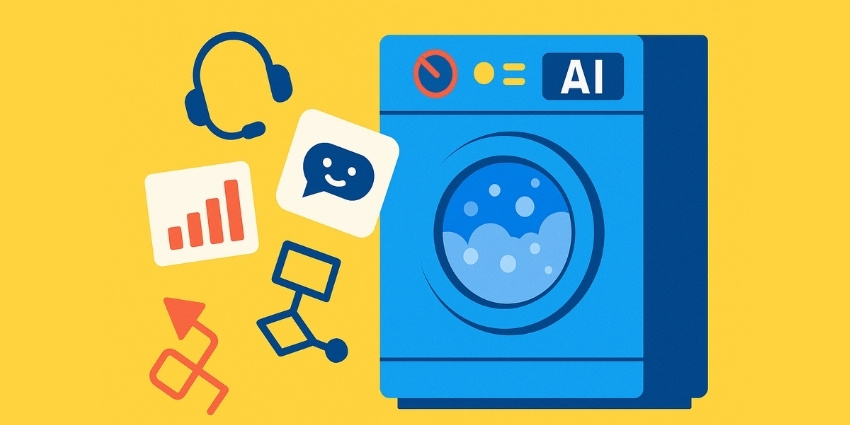I’ve always noticed that when people are very keen to tell you about their “AI,” it usually pays to ask one or two awkward questions. In customer experience technology, this has become something of a sport.
Every vendor seems to have an “AI-powered” solution. But lean in, and ask: “When you say AI… what kind are we talking about?” That’s when the room goes quiet, the sales deck gets shuffled, and the truth is often far less glamorous than the label.
This blurring of definitions — known as AI washing — is spreading fast. And you see it most clearly in places like chatbots, routing, analytics, and even personalisation.
Example One: Three Chatbots, One Label
Chatbots are the poster child of AI in CX. But under the hood, they come in three very different flavours.
- Scripted Chatbots – Decision trees with a friendlier face. Reliable for FAQs, but quickly fall apart if a customer strays off-script.
- Generative AI Chatbots – Powered by large language models. They can improvise and sound natural, but sometimes hallucinate answers with alarming confidence.
- Agentic AI Chatbots – The real deal. They don’t just chat, they act: rebooking flights, processing refunds, or updating accounts without human handover.
The problem? All three are often lumped under the same “AI” banner. Which means a buyer expecting agentic capability might end up with little more than an expensive FAQ page.
Example Two: AI Routing vs. Old-School Rules
Another favourite playground for AI washing is call routing.
Legacy routing has been around for decades. “If customer selects option 1, send to Sales. If they’re VIP, send to Priority Queue.” Simple, effective, but not exactly cutting-edge.
Now, vendors rebrand this as AI routing. True AI routing should analyse intent in real time, predict needs from history, and route customers to the best-fit agent or channel. But in many cases, it’s still the same rules engine with a new coat of paint.
It’s a bit like me putting on a tracksuit and insisting I’m an Olympic athlete. The outfit has changed, but the performance hasn’t.
More Traps to Watch
Chatbots and routing aren’t the only culprits. AI washing shows up in plenty of other corners of the CX stack:
1. AI Sentiment Analysis
- The Pitch: “Our AI understands customer emotions in real time.”
- The Reality: Often just keyword spotting. Words like angry or cancel trigger a flag, while tone of voice and cultural nuance are ignored. True AI sentiment analysis should combine linguistic, contextual, and even acoustic cues — but many tools don’t.
2. AI-Powered Analytics Dashboards
- The Pitch: “Our analytics are now AI-driven.”
- The Reality: A fresh UI slapped on top of the same dashboards. In some cases, “AI” just means auto-generated charts. True AI analytics should find hidden patterns, predict churn, or suggest next best actions — not just visualise yesterday’s KPIs.
3. Predictive Customer Insights
- The Pitch: “Our AI predicts what your customer will do next.”
- The Reality: More often than not, it’s a set of simple historical correlations, like “customers who called twice last week are likely to call again.” Proper predictive AI requires sophisticated modelling and constant retraining, but many vendors sell static rules as “predictive.”
4. AI Voice Biometrics
- The Pitch: “Authenticate customers instantly with AI voice recognition.”
- The Reality: In some cases, it’s still based on phrase matching (“my voice is my password”) with little or no actual machine learning. True AI biometrics should account for accents, background noise, and changes in a customer’s voice over time.
5. AI Personalisation Engines
- The Pitch: “Every customer gets a unique, personalised journey with AI.”
- The Reality: Many systems are just segment-based marketing with fancy branding. “AI” personalisation often amounts to “people who bought X also bought Y.” True AI should deliver real-time, 1:1 personalisation based on dynamic data and behavioural signals.
6. AI Knowledge Management
- The Pitch: “Our AI automatically answers any question by searching your knowledge base.”
- The Reality: Often little more than keyword search wrapped in natural language. A customer might type, “How do I cancel my plan?” and the system just matches “cancel” with the closest article. True AI should retrieve, summarise, and contextualise knowledge across multiple systems.
7. AI Workforce Optimisation (WFO)
- The Pitch: “AI automatically schedules the perfect workforce.”
- The Reality: Many tools are still spreadsheet logic with basic forecasting, rebranded as AI. Real AI WFO should ingest demand signals, predict spikes, and adapt schedules in near real time — not just shuffle shifts based on last year’s patterns.
Each of these promises transformation. But when the AI isn’t there, buyers end up with the same old technology in new packaging.
Why This Matters
For CX leaders, these blurred definitions carry serious consequences.
- Buy a scripted bot expecting agentic AI, and customers will abandon in frustration.
- Buy “AI routing” that’s really just legacy call flows, and you’ll never see promised efficiency gains.
- Buy “AI analytics” that’s little more than prettier charts, and you’ll miss out on the predictive insights your strategy needs.
Meanwhile, vendors genuinely investing in machine learning, conversational intelligence, and predictive modelling risk being drowned out by hype.
The Takeaway…
If every chatbot, routing engine, and dashboard is “AI,” then nothing is.
So next time a vendor rolls out their AI pitch, maybe channel your inner Louis Theroux and ask a few gently awkward questions: “How exactly does this differ from what you sold five years ago?” or “Can you show me the real AI at work, not just in the demo?”
The silence that follows might tell you more than the sales deck ever could.
Join our CX Today community on LinkedIn to keep the debate going with 40,000+ peers, and subscribe to our newsletter for the weekly rundown of crucial CX news.







